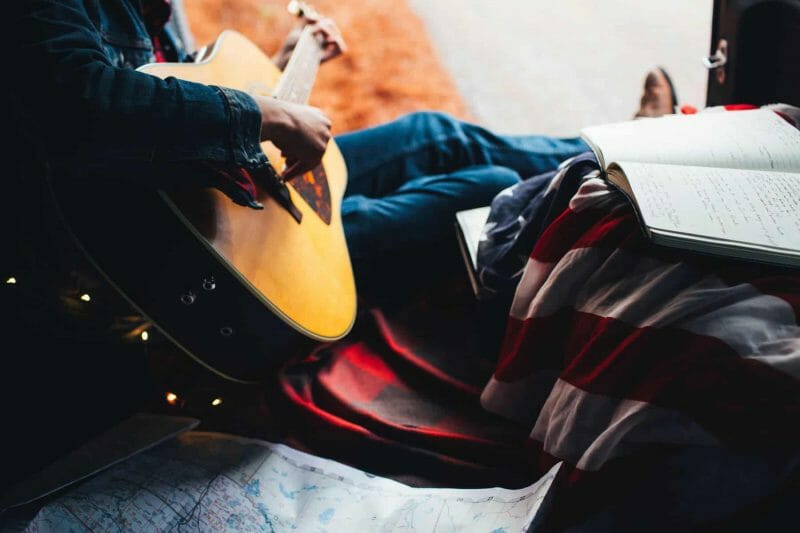Song structure is crucial to writing great music.
Have you ever sat down to write a song only to ask yourself, “Where do I even start?” Understanding song structure will help you stay creative and avoid writer’s block.
If studying song structure feels a bit academic and intimidating at first, fear not. It’s actually super simple.
In fact, you already know exactly what good song structure sounds like!
In this quickstart guide, we’ll talk about:
- Why song structure is important for songwriters of all genres
- Different song structures you can start using right away
- Common song structure terms
If you’re like most composers and writers, you’re probably producing your own music as well. We put together a brief training that covers a totally new approach to music production. Until now, everyone has been teaching production totally backward. Just click below to watch. Get industry-quality mixes every time (steal this framework)
But if you just want to learn about Song Structure specifically, keep reading.
What is Song Structure?
Structure gives our songs organization. Essentially, it’s the arrangement of the different sections in a song, some of which repeat.
How a song is organized plays a huge role in whether the listener is invited in or kept at arm’s length.
A song’s structure can allow your listeners to really experience your story through use of certain techniques and formatting. For example, repetition of lyrics or use of tension and release in chord progressions.
What’s Good Song Structure?
Structure in songs is something we’re all tapped into on a deep level. We innately “feel” structure, even of we’re not fully aware of it.
Remember how I said that you already know what good structure sounds like? That’s because we can all feel out a song’s basic framework as we’re listening to it.
Good structure feels right. Nothing feels jarring, disorienting, or boring. You can listen along without any red flags or question marks appearing, like “Where is this going? How long have I been here?”
The Roadmap to Your Song
A song’s structure is its roadmap.

Imagine you’re in a car with your best friends and you want to drive somewhere you’ve never been before.
They’re stoked. You’re stoked! You’re all ready to get on the road.
But…
No one’s GPS is working on their phones.
Without GPS, you won’t be able to get there. You don’t know how to get there.
If you don’t have a roadmap (ok, your phone’s map app) in front of you, you’ll just have to follow the sun and take guesses along the way.
Write Better Songs in Less Time
So do yourself a favor and use a roadmap while writing your songs!
It’s a lot easier to come up with a cool melody than to finish an entire song. Using tried and true song structures will help you write songs that sound better and take way less time.
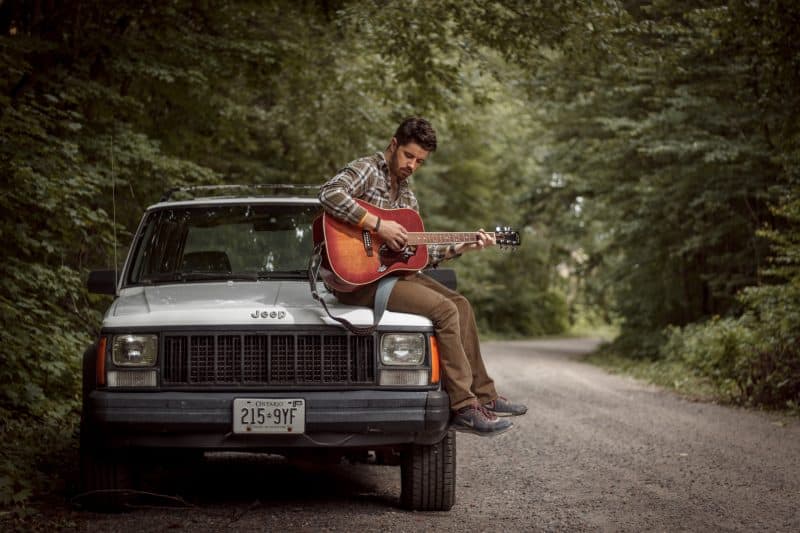
A firm song structure will tell you where the song should go next. You’ll waste a lot less time guessing and getting lost.
Plus…
Listeners Want Structure
Your audience wants to know the song will follow a similar format to other songs in the same genre.
They’ll need it to be at a reasonable length without too many new sections. You don’t want them to get completely lost in a song that feels like it’s dragging along forever.
Without good structure, people will need a lot of concentration to listen to your song and probably won’t enjoy it as much.
The 4 Steps of Good Structure
Structure helps listeners know right where they are, because they know where they’ve been.
So what are some of the ways you can provide structure for your listeners? Here are some opportunities:
-
Embrace Repetition
A repetitive section in your song is a great opportunity to invite your listener into your song. Much like a single gas station glimmering on a lonely highway, your listeners will know what’s coming when they hear that repeating section start up. They’ll quickly learn the words and be singing along in no time.
-
Use Tension and Release Wisely
Keep your songs dynamic. To tell a story, you want to lead your listeners through various moments of heightening tension, followed by a release. This is something storytellers use in all mediums, from music to movies to novels. Ask yourself, “Does my song have very little tension/release? Or is there too much?”
-
The Hook is Sacred
Another way to provide climactic moments in your songs is to only deliver your hook at points of high tension. Let your hook be the release the ear has been listening for. It’s the most important line of your song, so make sure it gets the most impact.
-
Use Transitions to Link Sections
Does each section of your song seem to rush right into the next? Add a little musical space between sections to break them up a bit. This gives the ear a rest before moving on. Conversely, if your songs have too much space between sections, it can get boring fast. Chop overly long sections in half.
NOTE: Be sure to check out our 11 top tips for finishing your songs:
Repetition is Your Friend.
Pop music had been stereotyped for being repetitive and dumb.
That couldn’t be farther from the truth! While that whole can of worms is worth a whole ‘nother blog post, one thing definitely needs to be said:
Repetition does not equal dumb.

Repetition is a highly effective tool that can make songs irresistible.
Regardless of your opinion of current music, pop really gets this right.
Repetition keeps your listeners engaged. It teaches them the song as they listen to it.
This is why we hear so many sections, like choruses or hooks, that are short and repeat frequently. If a listener can learn the chorus after one pass and sing along on the second pass, you’ve made a fan!
Popular Song Structures
For these examples, I’ll be breaking down song structures of popular music in different genres. This way we can take a look at how they’re made.
Letters of the alphabet will denote different and repeating sections, as well as the names for each section.
For example, a song structure of Verse-Chorus-Verse-Chorus will look like ABAB.
Ok, good? Let’s dive in!*
*Hey! Not sure what some of these words mean? Scroll down to the big list of song structure terms at the end of this post.
Verse – Chorus – Verse – Chorus – Bridge – Chorus
ABABCB
This is perhaps the most common song structure in pop and country music today. It’s practically ubiquitous – we hear it everywhere.
Dan + Shay’s “Tequila” uses this well-loved structure. This song plays on both pop and country stations across the country.
Verse – Prechorus – Chorus – Verse – Prechorus – Chorus – Bridge – Chorus
ABCABCDC
This structure is nearly identical to the previous one. Except here we have the addition of a prechorus.
You can hear this structure in Taylor Swift’s “Delicate.” The prechorus is at the very top of the song instead of a music-only intro.
Verse/Refrain – Verse/Refrain – Bridge – Verse/Refrain
AABA
This song structure is used less today, though we still hear it come up from time to time.
There is no chorus. Typically each verse will have a refrain at the beginning or end of it to be the repetitive element.
It can be heard in a lot of bluegrass, gospel, and occasionally country music. “Somewhere Over the Rainbow” and Willie Nelson’s “Crazy” are two examples.
Verse – Chorus – Verse – Chorus
ABAB
Seen even less in pop music today, this structure does still work in some circumstances.
At its worst, this structure can be overly repetitive and boring. At its best, the story is killer and works well.
Kip Moore’s “Somethin’ ‘Bout a Truck” falls into this structure, depending on how long you consider the verses to be.
So does Camila Cabello’s “Consequences.” (Though it’s closer to AABABB with a short musical interlude and a lyrical change on the last chorus).
The adjustments to a regular ol’ ABAB structure in both of these example songs was a great call. It keeps each song from getting boring.
Verse – Chorus – Hook – Verse – Chorus – Hook – Bridge – Chorus – Hook
ABCABCDBC
In pop music, we’ve seen the reinvention of the hook.
It’s gone from a single line of a chorus to its own independent stanza immediately after a chorus. They are filled with delightful musical energy and a repetitive lyric.
You can hear a hook in action in Dua Lipa’s “New Rules,” Selena Gomez’s “Back to You,” and in many other contemporary pop hits.
Chorus – Verse – Chorus – Music – Chorus – Bridge – Chorus
ABACABA
Now let’s get weird.
Actually, this structure isn’t that weird at all. This is called a “Rondo,” or at least this is a contemporary take on a Rondo.
It’s been around long enough (since the 13th century!) to be utilized by the likes of Bach, Beethoven, and Mozart. Structure like this is heard mostly in music from days gone by, but there’s no reason why a contemporary spin like this couldn’t work in one of your songs.
In fact, check out this video from Brian Gossard explaining how a rondo works by playing it with a band. Sounds current, right?
Breaking the Rules
While certain song structure is expected across different genres of music, I strongly feel that rules are meant to be broken. That’s where innovation is made!

I encourage you to try new things with your song’s structure when it feels right. But that’s the key – it has to feel right.
If your structure is a bit too avant-garde, you risk losing listeners.
Good structure leads the listener along the journey. Remember, a song’s structure is the listener’s roadmap.
Experiment away! Share it with friends. Share it with other songwriters.
See what kind of reception your songs get. Listen to your gut.
Then make the call: what kind of structure best serves the song?
Vocab List
Here’s a quick go-to reference for some common elements of song structure.
Intro
The short musical section that kicks off a song. Typically includes a musical hook (a.k.a. riff or repetitive, signature melody).
Ariana Grande – thank u, next
0:39-0:46
Verse
Designed to give the listeners information in the story. Typically includes some who, what, where, how, why type of information. Moves the story along. The meat of your song.
Ariana Grande – thank u, next
0:47-1:04
Prechorus
A section designed to link your verse with your chorus. Musically, a pre feels like you are “ramping up” to your next section.
Ariana Grande – thank u, next
1:04-1:24
Chorus
The sing-along-able, repetitive section of your song. It’s usually repeated around three or so times throughout. The chorus can contain your hook or lead to it.
Lyrically, it’s approached as the “summary” of your song.
Ariana Grande – thank u, next
1:04-1:41
Refrain
Typically found in AABA types of songs, a refrain is a line or two that repeats at the end of each verse. Think of it as the hook for your verses.
Somewhere Over the Rainbow – Judy Garland
Hook
The line that “hooks a listener in.” This is the punchline, the line that brings everything else together.
It typically appears at the end of a chorus, the beginning of a chorus, or in its own section after a chorus. It’s usually the title of a song and is the essential heart of the song.
Dua Lipa – New Rules
1:08-1:26
Drop
Drops are particular to EDM and pop music. It’s a musical section that occurs with or after a hook, where the music takes the spotlight.
Before a drop, the song’s energy builds skyrockets. Then it’s dropped on the listener with a bouquet of sound and instrumentation.
It’s the release after the build.
Swedish House Mafia – One (Radio Edit)
0:54-1:02
Bridge
A bridge is a song’s turning point. It is a new section that occurs after your second chorus.
The function of a bridge is to add something new. That can be telling a new part of the story, offering new chords, a new melody, or new rhythmic structure.
Dan + Shay – Tequila
2:08-2:17
Middle 8
I’ve heard this term from folks from across the pond when they’re referring to a bridge. It’s usually eight bars long.
Breakdown
This is a musical moment where players can take a solo. It may be one instrument soloing, or players may take turns.
The underlying chords are usually the same as something we’ve already heard in the song (verse chords or chorus chords).
Dan + Shay – Tequila
1:56-2:08
Outro
A musical section at the very end of the song to lead out of it.
Ariana Grande – 7 rings
2:46-end
Topline
A topline refers to the melody and the lyric. Topline writers are brought in to provide a compelling melody and lyrics for a track that’s been written.
Stanza
A stanza is a section of lyrics that are grouped together based on a fixed rhyme scheme, meter, or length.
A verse is a stanza. A chorus is a stanza. Sometimes verses are two stanzas long.
Here are a few structures to try out:
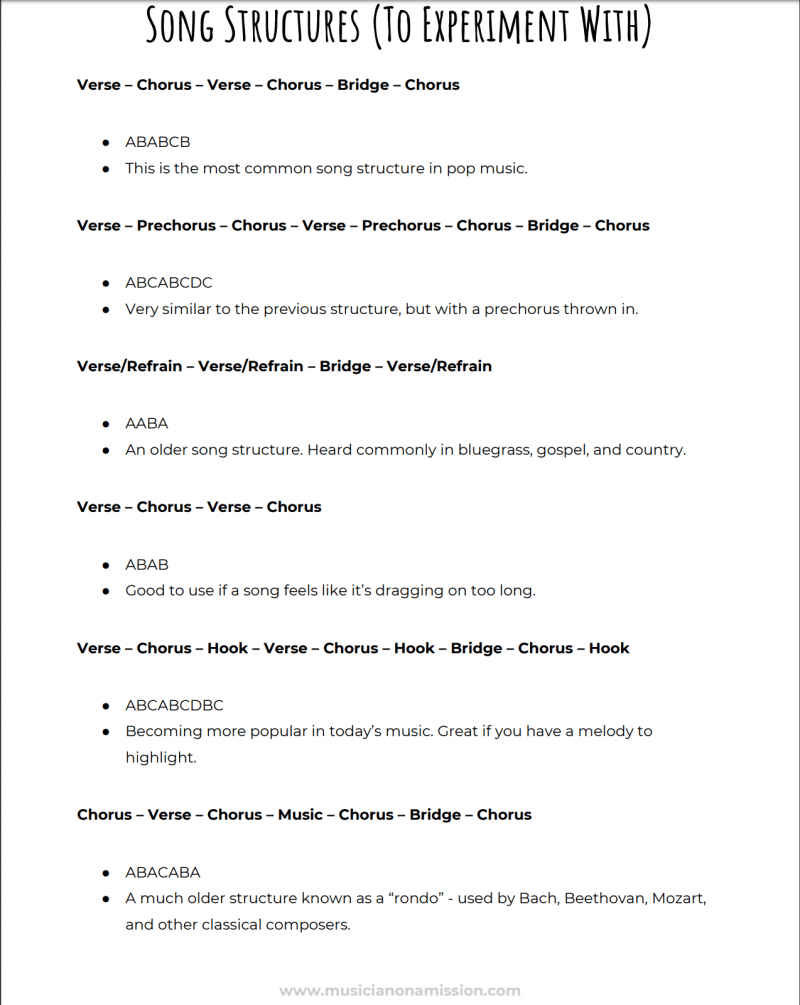
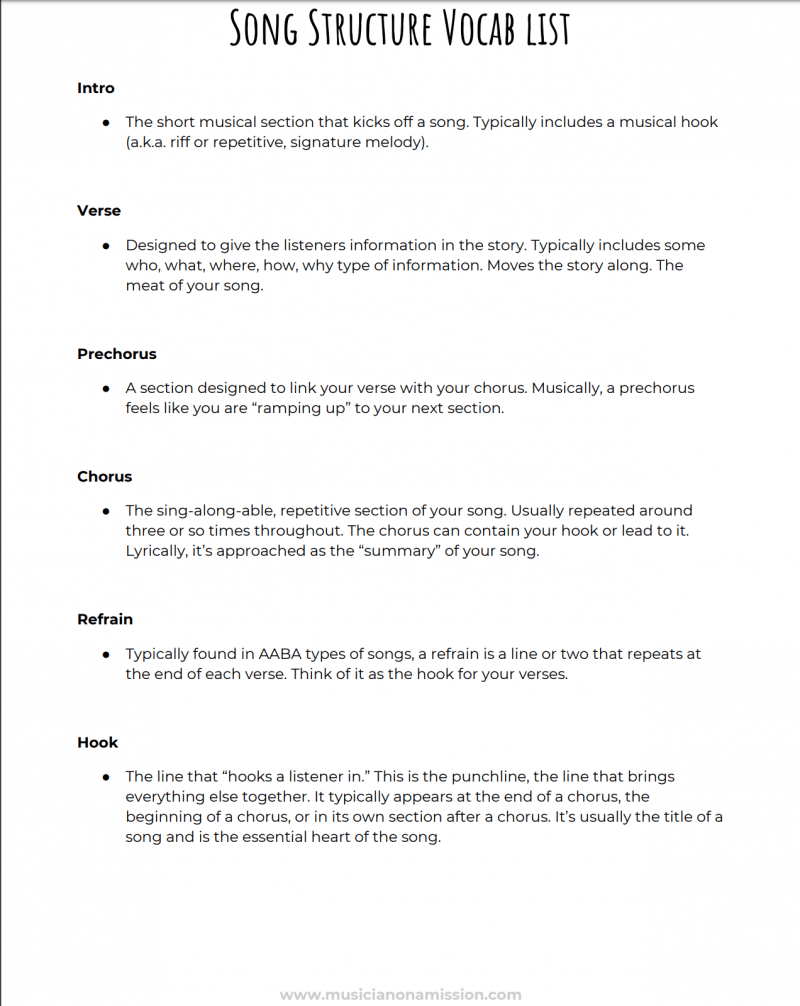
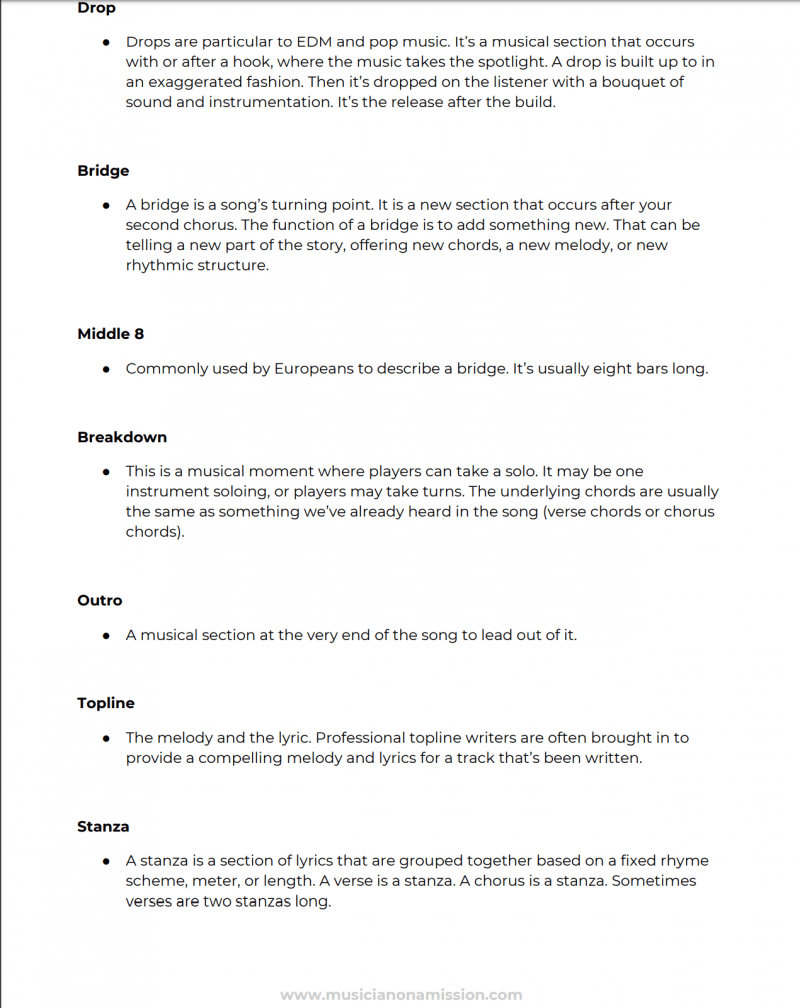
Where Should You Start?
The short answer is: Anywhere you please!
Many songwriters start with their hook, while others begin with the verse.
Some will even write all the music and melodies first then bring in lyrics.
If you feel like you’re pulled toward one section of your song first, write that first. Then see what else needs to be written around that section in order for it all to feel like it fits.
If you want to dig deeper into music production and learn what it actually takes to make mixes that sound pro… And you’re an intermediate or advanced producer… Be sure to check out the free masterclass: Enjoy!Next Steps


